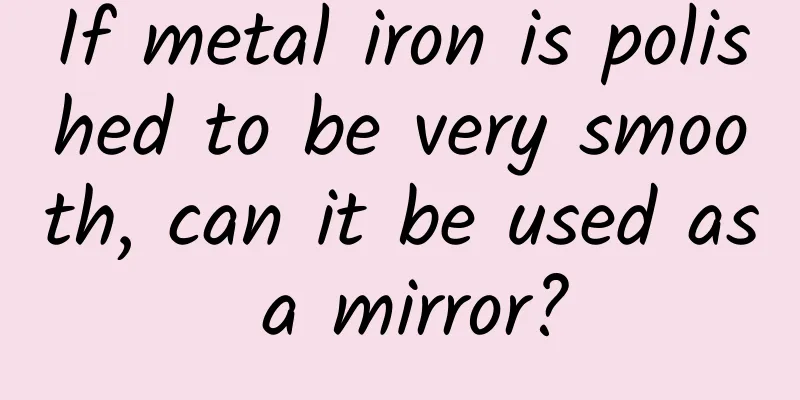If metal iron is polished to be very smooth, can it be used as a mirror?

|
Mirrors are common items in our lives. Traditional mirrors use flat glass as a substrate, while modern mirrors use more diverse materials. Looking back in history, obsidian, metal and other materials have also been used to make mirrors. So why haven't iron mirrors appeared? Can metal iron be used as a mirror after being polished smooth? Let's explore this today. 01 The Mirror World: Reflections from Ancient Times to the Present Mirrors have been closely associated with humans since ancient times. Initially, people saw their own reflections in rivers and lakes, which was the earliest "mirror". The mirror that the ancients used the word "jian" to describe was actually a basin filled with water. Water as a mirror Image source: Zhihu But did you know? In 8000 BC, the ancestors of Turkey made the first hard mirror with smooth obsidian, a material from volcanic magma with high reflectivity. This mirror was once mistakenly regarded as a "black jade mirror", but it actually originated from the Aztec civilization in Central America. Aztec obsidian mirror from Central America, one of the few in existence Image source: chinatimes.com As time went by, our ancestors began to try to use metal to make mirrors. According to archaeological data, the earliest bronze mirrors appeared in the Qijia culture period about 4,000 years ago. Making bronze mirrors is a process of integrating technology and art. Especially when the technical conditions in ancient times were limited, people added lead to lower the melting point. This innovation led to the large-scale production and popularization of bronze mirrors. A 2,000-year-old Western Han Dynasty gilded bronze mirror with the inscription "Daning, China" Image source: China News Service’s new media platform Huayu official account Not only metal, but also glass has entered the history of mirrors. In the Middle Ages, Venice, known as the "Glass Kingdom", created a mercury-coated glass mirror . First, tin foil was attached to the glass surface, and then mercury was poured on the tin foil. The mercury dissolved the tin to form a silver-white alloy. This layer of alloy adhered firmly to the glass surface, forming a true glass mirror. Silver mirror reaction Image source: sohu.com However, making a mercury mirror is too laborious, and it takes about a whole month to make one. Moreover, mercury is poisonous, and the mirror surface is not very bright. More than a hundred years ago, scientist Libich invented the silver-plated glass mirror. The British Pilton brothers improved the silver plating method by continuous silver plating, copper plating, painting, and drying. From then on, mankind entered the "modern mirror" era. 02 Why isn't iron used to make mirrors? Since there are bronze mirrors, are there “iron mirrors”? To answer this question, we must first understand the basic principles of mirrors. When light encounters a substance, it will absorb, transmit, or reflect. Reflection can be divided into: specular reflection and diffuse reflection. We see that sunlight is similar to parallel light. When the light is reflected by a smooth mirror, it propagates in a specific direction (following the law of reflection). When it is reflected on a rough surface, although the light still follows the law of reflection, it propagates in all directions due to the tiny irregular structures of the rough surface and spreads out in all directions. Although pure iron (Fe) can be polished very smoothly to reduce its diffuse reflection, theoretically it can be like a mirror. However, in practice, the surface of metallic iron is easily oxidized to form iron oxide (Fe2O3), and the loose and porous structure of iron oxide makes it impossible to effectively reflect light. Therefore, the brightness of a mirror made of pure iron is still too low. But with the advent of stainless steel, the iron-based surface is no longer loose and porous, but is covered with a dense chromium oxide passivation film, which greatly improves its reflective ability, so it is also used to make mirrors. Stainless steel mirror building Image source: Prefabricated Building Network Common mirror stainless steel is divided into four grades: 6K, 8K, 10K and 12K. Take "8K" as an example, where "8" refers to the proportion of alloy components, and "K" refers to the level of reflectivity after polishing. Generally, 8K mirror stainless steel has achieved the polishing effect of ordinary mirrors. Continuing to grind to 12K mirror stainless steel can achieve ultra-clear surface, no grinding head and no scratches. 03 Some special mirrors In addition to ordinary mirrors, there are actually many magical mirrors. The Shanghai Museum has a magical mirror from the Han Dynasty: although its appearance is no different from an ordinary round bronze mirror, whenever light shines on the mirror, it can reflect the patterns on the back of the mirror, just as if the entire mirror is penetrated by light. This is the light-transmitting mirror "Jian Ri Zhi Guang" from the Western Han Dynasty. "Sunlight" translucent mirror Image source: sohu.com Shen Kuo of the Song Dynasty revealed its production principle to us: "During casting, the thin parts cool first, but the back with the text is thicker. It cools down later and the copper shrinks more. Although the text is on the back, there are traces of it on the mirror surface, so it can be seen in the light." The light-transmitting phenomenon occurs because the cooling speed during quenching is inconsistent, which results in many convex and concave mirrors on the surface of the bronze mirror. When reflecting light, a concave mirror can make the light converge, appear brighter, and form an image before the lens focus, like an ordinary mirror; while a convex mirror can make the light diverge, appear darker, and form an image after the lens focus. When light is irradiated from the side or at a specific angle of incidence, people can see brighter handwriting and patterns in the reflected image . These are the images on the back of the mirror, and from the surface, the bronze mirror seems to be able to "transmit light". The funhouse mirror is also a magical existence. In the 1830s, Joseph Plattner of France invented the funhouse mirror. Imagine that when you walk into a mirror, you suddenly find that you have a big head or become tall and thin. This funny and distorted image is caused by convex and concave mirrors. Its principle is that the irregular reflection and focusing of light caused by the curved mirror creates a scattered image. The century-old funhouse mirror in the lobby of Shanghai World Expo Image source: The Paper ∙ Quick Look A concave mirror has a positive focusing power, which makes parallel light rays shining on its surface converge to one point after reflection. **When a person's face or body is placed in front of a concave mirror, the light is reflected when passing through the concave mirror, causing different parts of the face or body to be magnified, thus presenting a distorted, deformed or fattened effect. A convex mirror has a negative focusing power, which makes the parallel light rays passing through it disperse. When a person's face or body is placed in front of a convex mirror, the light is reflected on the surface of the convex mirror, causing different parts of the face or body to be shrunk or thinned, thus producing a funny visual effect. When it comes to one-way perspective mirrors, we should all have wondered why one party can see the other side, while the other party can only see themselves? One-way mirror generally refers to one-way glass, also known as one-way perspective glass, etc. Its working principle is completely based on the physical properties of light. The key lies in a very thin metal film, which is thin enough to allow part of the light to pass through and reflect another part of the light. One-way mirror Image source: sohu.com This depends largely on the lighting conditions on both sides. When one side is very bright and the other side is relatively dark, people on the bright side will see their own reflection because most of the light emitted from this side is reflected back, and very little light is transmitted through the darker side. On the dark side, because part of the light from the bright side can penetrate the metal film, people can see the bright side through the glass. The "secret" of one-way transmission glass lies in its metal film and the ambient light conditions. If you change the lighting conditions, such as making the dark side brighter or the bright side darker, the glass will lose the one-way transmission effect on the original side and show one-way transmission on the other side. In recent years, smart mirrors have opened up a future full of infinite possibilities for us. They look like ordinary mirrors, but they actually have screen display, computing and other functions , and can provide more functions and interactive experiences. They can be operated by touch and can view information such as news, weather, time and notes. Smart mirror Image source: sohu.com The magic of light has leapt out of the mirror and become an indispensable part of our daily life. In this world of light and shadow, the mirror is not only a tool for us to cut hair and put on makeup, but also a historical heritage that carries thousands of years of wisdom and culture. Author: Ran Guoyong, PhD student at Fudan University Editor: One person Acknowledgements: Professor Ma Ruguang from the School of Materials Science and Engineering at Suzhou University of Science and Technology provided scientific guidance for this article |
<<: Clear waves protect the central axis. How did the water system of the central axis evolve?
>>: Mixed infection has occurred! Many places have issued reminders: Wear a mask!
Recommend
What is the method for consecrating the Wenchang Pagoda?
Wenchang Tower is a kind of mascot, and its abili...
Information flow advertising: This is what pictures and texts with high click-through rates look like!
When you choose a channel , each channel will tel...
How much does it cost to develop a small program for travel products on the market in Nantong?
In order to better penetrate into various industr...
Tencent advertising promotion quantity, time and basic overview!
1.How many ads can one account create? In one acc...
How to do marketing for post-00s?
The post-00s have their own opinions, and they ha...
Online education customer acquisition methods and conversion strategies!
Out of curiosity about the online education indus...
When will the 2020 epidemic end and when will the 2020 epidemic be lifted?
I want to go out, but when is it safe? Will the e...
Full set of VIP paid SEO training for the entire network with black hat SEO tutorial
Full set of VIP paid SEO training for the entire ...
From rejection to acceptance, Chanel also started to engage in e-commerce
Chanel, a luxury brand that has always been again...
Analysis report on PROYA and FASHION’s Tik Tok live streaming
2021 is considered to be the first year of brand ...
Tencent Advertising 520 Valentine's Day Advertising Plan
“What to give as a Valentine’s Day gift” is an an...
Case | Account optimization strategy to reduce ACP by 70% in the real estate industry
Today, Qingguajun will share with you an optimiza...
Can hair dyeing cause cancer and hair loss? What should I do if manicures damage my nails? West China experts explain it in one article!
Only 3 days left until the holiday! On the eve of...









